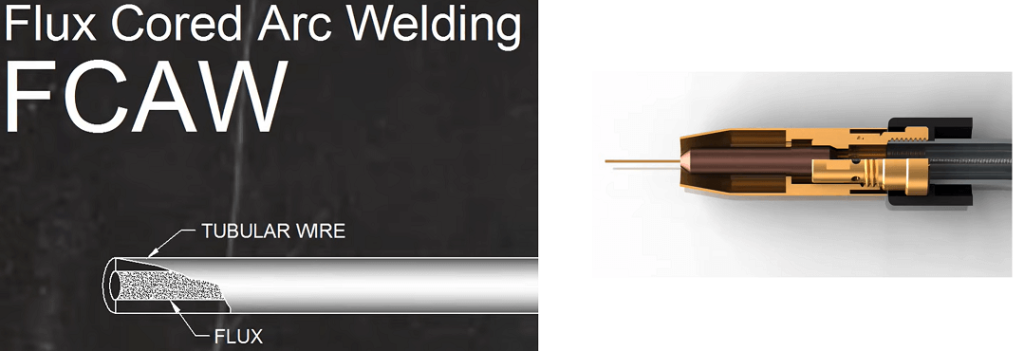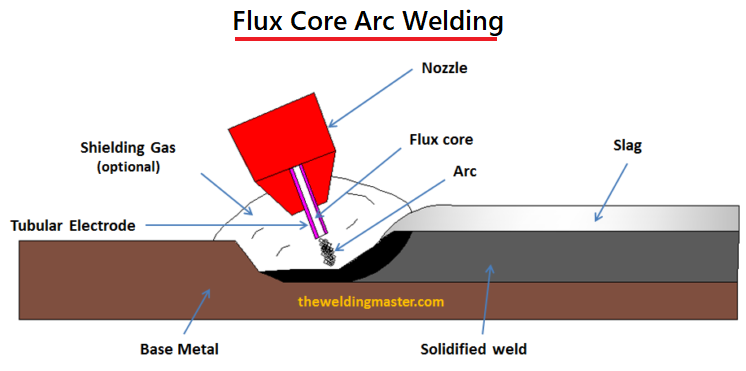While some are made for smaller welds and basic usage, others might be suitable for heavy-duty and industrial usage depending on the type of welding machine that you get. This includes welding machines like MIG welders, TIG welders, gas welders, and also flux core welders. Out of all these, flux core welders are considered as a great pick for large-scale projects. And here we have explained all of the important details regarding flux core welding and flux core welders.
Flux Cored Arc Welding Basics
Before going ahead and taking a look at all of the detailed information related to flux core welding, you should know its basics and why it is considered as one of the best options.
In case you are not familiar with the same, Flux Core Arc Welding or FCAW is an easy-to-use welding process as not only is it semi-automatic, but it is quite similar to MAG welding which is also highly popular for heavy-duty usage. For the operation of a flux core welder, a continuously wire-fed electrode is combined along with a constant voltage welding power supply. Since the electrode is fed continuously, you can focus on the welds and perfect them instead of worrying about the electrode.
Why Flux Core Welding?
Apart from being ideal for heavy-duty usage, flux core welding is also fairly versatile since it can be optimized as per your usage. While some welding jobs may need a shielding gas, others can be done without it. If you are not using a shielding gas, then it can be ideal for outdoor usage where the wind might blow away the shielding gas. But the primary reason for using flux core arc welding is the fact that you get high welding speeds from it making it ideal for heavy-duty usage.
Flux Core Welding Benefits
Even though we will take a deeper and more extensive look at all of the advantages and disadvantages of flux core welding, understanding its benefits to know why it might be preferred over other types of welding processes. A great thing about flux core welding is that it can be easily used with thicker materials with ease. Since it can also work without shielding gas, you can use it in a lot of scenarios where the gas may blow away. If you wish to make highly precise and detailed welds using your welding machine, then a flux core welder can be a great option as its electrode gets fed automatically.
How does Flux Core Arc Welding Work?
Now that you know more about flux core arc welding and its major benefits for using it over other types of welding processes, you should know more about its functioning. By knowing the functioning of your welding machine, you will be able to use it more efficiently while being able to fix little issues that you may face while using it. The key working principle of a flux core arc welder includes using a high heat electric arc for fusing the welding material along with the material that you are welding. When the electrode of a flux core welder is fed continuously, it comes close to the base material. Then, an electric arc is produced between these two which releases a lot of heat for completing the welding process. Unlike many other types of welding processes, FCAW or flux core arc welding relies on hollow and tubular electrodes which are filled with flux so that you do not have to use flux separately. Even though the basic functioning of all flux core arc welding machines is the same, it may vary slightly depending on the way that you are using it. While some of you might be using an external shielding gas while welding, others may prefer using it without any gas. Apart from the shielding gas, the flux present inside the core also melts to protect the welded metal resulting in a dual shielding. As a result, you can easily weld thicker metals if you are using a shielding gas blend of argon and carbon dioxide. Although, if you do not have any issue with slightly higher defects but wish to use your flux core welders outdoors, you can also use it without any gas. This can be ideal if there is a lot of wind blowing and the shielding gas will not be able to protect the welded metal. Such a self-shielding ability is developed thanks to its flux-filled electrodes that form their own shielding gas when heated up. Apart from being a great option for outdoor usage, this type of self-shielding welding is also great for portable usage as you do not have to carry any shielding gas cylinders.
Flux Core Welding Tips
Whether you already have a flux core welding machine in your workshop or planning to get a new one, it is only going to be effective enough for you when you know how to operate it perfectly. While the primary welding basics stay the same for a flux core welding machine as well, there are a few tips that you should keep in mind which includes the following:
While using a flux core welder, you need to make sure that the electrode polarity is set to negative and not positive. Keeping it properly cool with proper ventilation is essential. During your welding process, you should always clean all slag after each pass to get clean welds. If you wish to make flat welds, you should be welding at 90 degrees and 10 degrees back. On the other hand, T joints are to be made at 45 degrees and lap joints at 60-70 degrees within a single weld. For a horizontal angle, the welding gun needs to be moved upwards by 10 degrees. And for vertical angle, you need to move it down for thinner metals and up for metals thicker than ¼ inch. In most cases, the parameters of your welding machine should be reduced by 10-15% for the best results.
Which Metals can be Welded with Flux Core Welding?
Before you go ahead and use your flux core welding machine in your workshop or any other remote location, ensure that you are only using it with the right compatible metals. Fortunately, a great thing about flux core arc welding is that it is highly versatile and works with all kinds of metals. This includes carbon steel, stainless steel, cast iron, and surfacing alloys. Although, if you wish to weld aluminum objects, then you will not be able to use it since you will need either a MIG or a TIG welder.
What is Flux Core Welding used for?
Those of you who are still confused regarding flux core welders in comparison to others might be interested in knowing even more. Whenever you are buying any kind of tool or machinery for your workshop, it can be a great idea to consider its advantages and disadvantages. Similarly, before you go ahead and pick a flux core arc welding machine over others, make sure to consider the following advantages and disadvantages:
Advantages
Thanks to the dual shielding characteristic of a flux core welder, not only it can be used for thick metals, but you can also use it outdoors where using a shielding gas might not be viable. If you are not using a shielding gas with your flux core welder, then it also makes for a great portable option as there is no gas container involved. Since flux core welders rely on continuously fed electrodes, their overall welding speed is much faster and more viable for large-scale operations. You can use your flux core arc welder for making welds in almost all kinds of angles and positions with almost similar results as long as you are using it the right way. If you are using your flux core welder properly, then there is a very low chance of facing any porosity issues.
Disadvantages
Similar to many other types of welding processes, flux core welding can also produce noxious smoke which is not good for your health in the long run. In some cases, you might even face porosity if the shielding gas is not able to escape before the welding metal sets. Because flux core welding uses hollow electrodes for welding, you have to take extra care of them for storage and transporting. If you are not feeding the electrode continuously while using a flux core welder, then you may face many issues. As mentioned in the flux core welding tips earlier, the slag needs to be removed in each welding pass which can be quite hectic for many.
Conclusion
After checking out all the various details regarding flux core arc welding and flux core welders stated above, you must know most details regarding this type of welding process. This can be handy to choose flux core arc welding over other types of welding processes. You can also learn how to get the most out of your flux core welder thanks to the various tips stated above. If you have gone through all these flux core welding details, make sure to share your thoughts in the comments section. You can also post any questions down there if you have any! Comment * Name * Email * Website
Δ







![]()